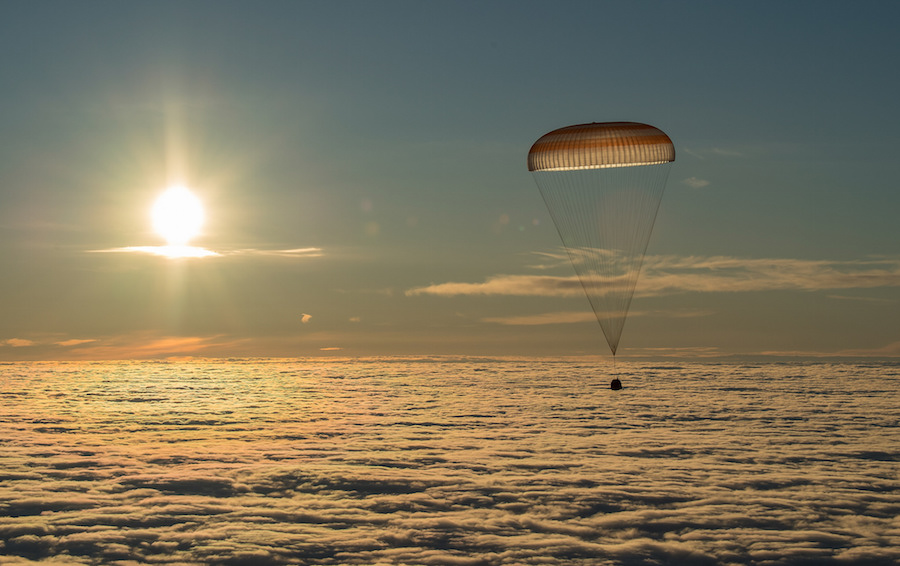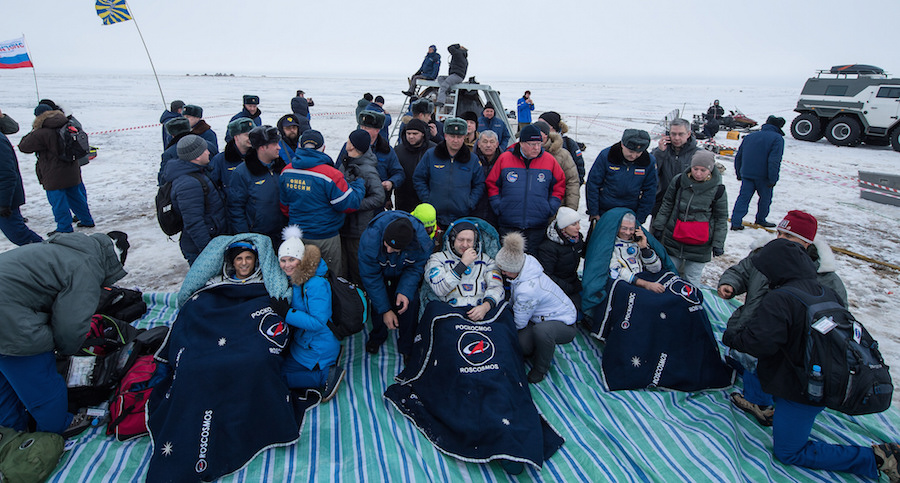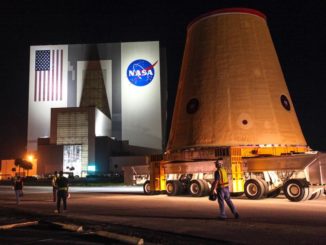STORY WRITTEN FOR CBS NEWS & USED WITH PERMISSION

Bidding their crewmates farewell, a Russian cosmonaut and two NASA astronauts boarded their Soyuz ferry craft, undocked from the International Space Station and fell back to Earth Tuesday, landing safely on the snowy steppe of Kazakhstan to close out a 168-day mission.
With cosmonaut Alexander Misurkin at the controls in the Soyuz MS-06 spacecraft’s center seat, flanked on the left by flight engineer Mark Vande Hei and on the right by Joe Acaba, the Russian spacecraft separated from the station’s Poisk module at 6:08 p.m. EST (GMT-5) to begin the three-and-a-half-hour trip home.
After moving a safe distance away from the station, Misurkin and Vande Hei monitored a critical four-minute 39-second rocket firing that slowed the spacecraft by 286 mph, just enough to lower the far side of the orbit deep into the atmosphere for a fiery plunge back to Kazakhstan.
Slamming into the discernible atmosphere a half hour later at nearly five miles per second, the Soyuz descent module, protected by a heat shield, endured temperatures of more than 2,500 degrees Fahrenheit and a deceleration of three times the force of Earth’s gravity before slowing enough to deploy the spacecraft’s main parachute.
The Soyuz then descended into dreary winter weather, with several inches of snow at the landing site, low clouds and freezing temperatures. Television cameras were unable to spot the spacecraft during the final moments of entry, but the crew module settled to a rocket-assisted upright touchdown near the town of Dzhezkazgan at 9:31 p.m.
Russian recovery crews and medical personnel, along with a contingent representing NASA, reached the scene within a few minutes to help the returning station fliers out of the cramped capsule as they began readjusting to the unfamiliar tug of gravity. And equally unfamiliar wintry weather.
But all three appeared healthy and in good spirits, smiling and chatting with recovery crews amid satellite phone calls to family and friends.
The on-time touchdown closed out a 168-day five-hour mission since launch from the Baikonur Cosmodrome last Sept. 12, a flight spanning 2,688 orbits and 71.1 million miles.

With landing, Misurkin’s total time in space over two station flights stood at 334 days while Acaba, veteran of a space shuttle flight and a previous station visit, had logged 306 days aloft. Vande Hei was completing his first space mission.
During their stay in orbit, the crew helped unload four visiting cargo ships, welcomed three crew members aboard and monitored the departure of five visiting vehicles. All three also participated in multiple spacewalks, with Misurkin and Acaba each taking part in single excursions while Vande Hei took part in four.
After medical checks, Misurkin, Vande Hei and Acaba were to be flown in separate helicopters to Dzhezkazgan. From there, Misurkin planned to board a Russian jet for a flight home to Star City near Moscow while a NASA plane bound for Houston awaited Vande Hei and Acaba.
During a change-of-command ceremony Monday, Misurkin turned over responsibility for the station to Anton Shkaplerov, who now commands Expedition 55, and his two Soyuz MS-07 crewmates, Scott Tingle and Japanese astronaut Norishige Kanai.
Misurkin, speaking in English, thanked flight controllers around the world for allowing his crew “to use this station. We didn’t (break) almost anything, and hope we did some good things and helpful things for science. Looking forward now to going home, back to the Earth, to work with you guys on the ground.”
Said Shkaplerov: “You did very good job here on board International Space Station, and now you are ready to return to our planet.”
“Alexander, I am proud to be part of the great team you have been leading here,” he said. “Station is in excellent condition, and we’ll do all the best keeping this unique scientific laboratory fully functional and safe. With honor, I am taking command.”
Shkaplerov, Tingle and Kanai will have the station to themselves until March 23 when three fresh crew members arrive: Soyuz MS-08 commander Oleg Artemyev and NASA astronauts Ricky Arnold and Drew Feustel.
The space station’s crew normally is evenly split between the Russians and the U.S. segment, with three cosmonauts responsible for the lab’s Russian modules and three astronauts, representing NASA, ESA, Japan and Canada, operating systems and carrying out research in modules supplied by NASA, ESA and Japan.
NASA is responsible for arranging transportation for the station’s non-Russian crew members, known collectively as U.S. Operating Segment — USOS — astronauts.
The Russians decided in late 2016 to downsize their crews in the near term to save money, a decision that freed up seats aboard upcoming Soyuz spacecraft.
At roughly the same time, Boeing and the Russian aerospace company Energia reached a settlement in a $320 million dispute involving the Sea Launch commercial rocket company. As part of the settlement, Boeing obtained two Soyuz seats, one in 2017 and another in 2018, with options for three more.
NASA eventually agreed to buy all five seats from Boeing for an average cost of $74.7 million each, according to Space.com, modifying an existing contract with the Russians.
The two near-term seats allowed NASA to expand the USOS segment of the station crew from three to four, sharply increasing the crew time available for research. The other seats will serve as insurance in case commercial ferry ships being built by Boeing and SpaceX are delayed, requiring additional Soyuz flights for USOS crew members.
As of this writing, SpaceX or Boeing plan to launch unpiloted test flights of their new spacecraft around the end of August. If one or both of those flights gets off on time, the first piloted test flight, by either SpaceX or Boeing, could come in late December.
In the meantime, the Russians plan to resume their normal staffing levels after Feustel and Arnold return to Earth on Aug. 28.
But once the Boeing and SpaceX crew ships are certified for regularly scheduled flights to the station, NASA will be able to carry three USOS crewmates at a time, along with at least one cosmonaut, while Russian Soyuz spacecraft will routinely carry two cosmonauts and one NASA astronaut.
That will result in seven-member station crews in 2019 with four USOS astronauts aboard for the duration of the program, allowing NASA to maintain a high science output.
“Right now, having four USOS crew members on board, it gives you a lot more opportunities, not only to maintain the space station but then do the science we’re up there for,” Acaba said. “I think the number I heard is somewhere around 800 more hours of utilization. That’s a big chunk of science we’re going to be able to do by adding an extra crew member. So it’s pretty cool.”



